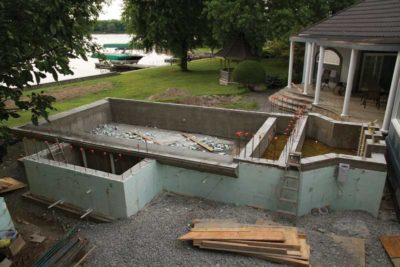Insulated concrete form basics

ICFs and insulated form technology were first introduced in Europe after the Second World War. The simplicity of construction, labour reductions, energy conservation, and overall structural strength are some of the many strong points of this technology. Initially, the forms were wood units which consisted of a two-sided form with a hollow core to accept poured concrete. With the advent of modern foam plastics, it replaced the wood form sides which greatly increased the insulation value and drastically reduced the weight of the forms. The foam form is held together with an inner tie or web that keeps them aligned and allows placement and attachment of reinforcing steel. The forms are stacked together similar to children’s building blocks. Once assembled, concrete is pumped into the forms using a concrete boom or line pump. While the concrete is curing, another direct benefit of the form’s insulation is the fact the concrete can remain moist during warmer months and insulated during colder months to protect the concrete. Once fully cured, the foam forms remain in place to be used as the final insulation layer of the pool structure.
ICFs for pools
The dual-sided insulation properties of ICFs are ideal for constructing a building or residence; however, there were some issues with regards to using them for installing a pool. The primary concern was how to properly adhere a traditional pool coating to a foam form, while the secondary concern was how the foam would behave behind the coatings. Could the foam sustain the lateral force created during the expansion of pool water during freeze/thaw cycles? Although products are available to be used as a base coat to prime the foam, which usually comprise highly modified polymer adhesives and fibre mesh for reinforcement, Roger Willis and Nudura (a Canadian manufacturer of ICF products) recognized the need for a modified form. The main requirement would be to still use a system that enabled the same efficiency and benefits as the standard ICFs, but would allow the inner face of the form to be removable. This would allow a traditional pool coating to be applied in the same manner used for traditional cast-in-place, shotcrete, or gunite pool construction.
Nudura created a variation of the inner web. The web continues to support the reinforcing steel and align the forms, but attaches only to one side of the standard foam form. Removable forming material such as plywood can be fastened to the interior pool side of the inner web. Once concrete has been placed and sufficiently set, the plywood side of the form can be removed. This alleviates coating the foam form with ‘experimental’ products or stripping of the inner foam to expose the concrete. The pool coating can then be applied directly to the exposed concrete.
It is all in the forming
Forming work for this pool structure was a lengthy process. With the many elements to be constructed, including the pool walls, vanishing-edge, perimeter over flow troughs, surge tank, and automatic cover bunker, careful designing and engineering of the formwork and reinforcing steel was a must. There was zero margin for error since the intention was to pour the concrete for all of these elements at the same time. This allows for a complete monolithic structure providing a near waterproof shell and to maximize overall structural strength and integrity.
The formwork also needed to be constructed with utmost precision to be able to achieve the ideal edge tolerances required (0.79 mm [0.031 in.]) for a perimeter overflow pool. The less the edge tolerance on a watershape of this nature would allow for a lower requirement of hydraulic pumping capacity. This allowed the use of less powerful circulation pumps to achieve the overflow. Ideally, a perimeter overflow pool at static water level with all circulation pumps shut off, should be close to perfect level.






